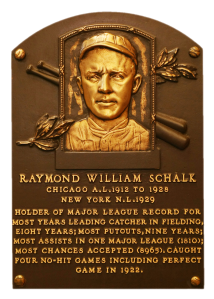
Year Inducted: 1955 (Veterans Committee)
Score: 5571
Catchers play the toughest position on the diamond. Not only are they counted on to be a fifth infielder (backing up the corner bases on throws, for instance), but also anchor the pitching staff, call the game, throw base runners out trying to steal, frame pitches, block pitches in the dirt and act as the field general. And, while most of these tasks were around for all of baseball (framing has become a recent issue, and they didn’t always back up throws in the infield), the position has changed some over the years. The early years were incredibly tough on catchers. The equipment wasn’t nearly as good as it currently is, and catchers had to deal with a lot of trick pitches. Pitches like the emery ball, spitball and others weren’t outlawed until the 1920 season (and some pitchers like Burleigh Grimes were allowed to still throw it since they had no other pitches), which caused a decent number of wild pitches and passed balls.
It was the toughest time to be a catcher, and the one considered to be the best defender of the time was Ray Schalk.In additional to being a tough position to play, catcher’s defense is incredibly difficult to quantify. As such, Schalk suffers somewhat in a heavy statistical study. Still, he was worth nearly 100 runs defensively. The advanced stats do back up the popular perception from his time. Even traditional stats show how good he was defensively. Schalk still, to this day, holds the career record for most double plays and is second in assists for catchers, while having fewer than 100 passed balls in his career. He also led in career putouts at the time of his retirement (and with the increase in strikeouts, he has been blown away by recent catchers). He definitely was the best defensive catcher of his time.
Unfortunately, he wasn’t very good offensively. He slashed .253/.340/.316 for a wRC+ of 88. His batting average is infamous as being the lowest for any position player in the Hall of Fame. He did show some power, though. Despite hitting only 11 home runs, he did manage to leg out 199 doubles and 49 triples to go along with 177 steals (quite impressive for a catcher). Overall, the advantage that he had defensively was almost entirely given away from his near-nonexistent offense.
Ray Schalk, though, has some importance beyond his numbers. Schalk was a member of the Chicago White Sox team that threw the 1919 World Series. Schalk wasn’t ever accused of being complicit in the act, and even agreed with the punishment handed down by then Commissioner Landis on the eight players that were accused of taking the bribe money. Schalk’s honesty and hard play, both in the World Series of 1919 and following the 1920 season that saw the suspensions handed down, helped the game heal from a near-fatal event.
Following his career (and some years spent as a manager and coach), Schalk spent time as a scout for the Cubs and served as the Assistant Coach for Purdue’s baseball team. When he finally retired entirely from baseball he was 72 years old, meaning he worked almost non-stop in baseball for over 50 years. Surely there is a place in Cooperstown for someone that spent half of a century making the game a better experience for everyone involved. He may not be the best statistically, but that doesn’t take away from his importance in the game’s history.
Stay tuned for the next update, featuring a player that holds a record that will probably never be broken.
On deck 7/10/16 this center fielder was the second player to hit 50 homers in a season.
2 thoughts on “#208-Ray Schalk, Catcher”